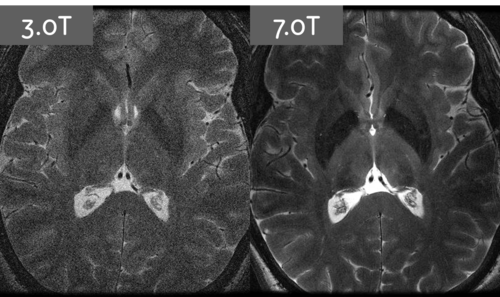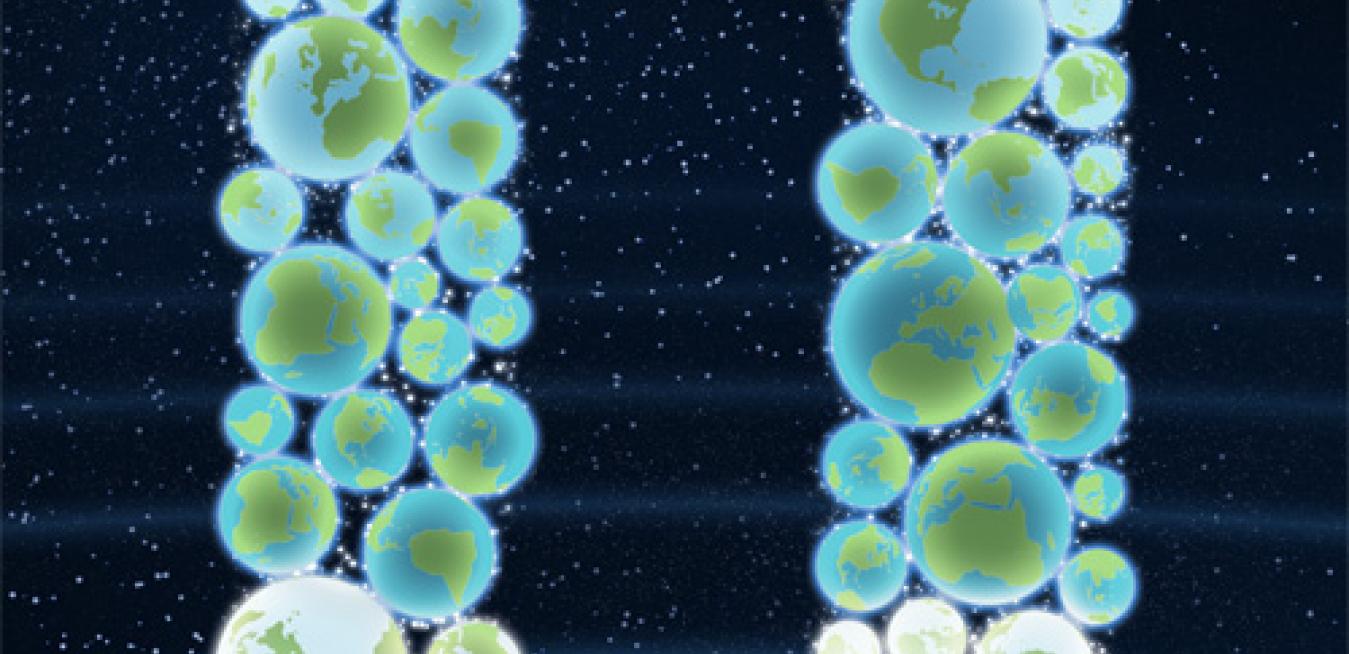At 7 Tesla (7T), the ultra-powerful magnet is almost five times stronger than magnets found in the majority of MRI machines used by doctors today. In fact, it is almost as strong as the 8T magnets guiding beams of high-energy particles zipping near the speed of light inside CERN's Large Hadron Collider in Geneva. “We are pushing the limits of medical science,” says Baldev Ahluwalia, magnetic resonance manager at GE Healthcare. (Tesla is a unit of magnetic field strength.)

A side-to-side comparison of brain images generated by a 3T and a 7T machines.
Magnetic resonance is still a relatively young imaging technology, compared to, say, X-ray, which has been around for more than a century.
The first MRI machines appeared in the late 1980s and Ahluwalia says that advancements and improvements in MR are helping with medical diagnosis and disease evaluation. “There are a fantastic number of opportunities to be explored.” He says researchers can focus the 7T machine, called the GE Discovery MR 950*, to study tissues and anatomical differences in a way that they could not do before.
Dr. Michela Tosetti is the leader of a team of MR scientists at the IMAGO7 Research Foundation in Pisa, Italy, the home of the first European GE 7T machine. Her group has been using it to look for markers of neurodegenerative diseases like ALS and Parkinson’s and to study epileptic patients. They will start soon to look for brain tumor lesions in children.
Right now, there are no radiologic techniques to study Parkinson’s, a progressive disease with symptoms that include shaking, stiffness and impaired coordination. Clinicians must rely on medical history and neurological examination, which can lead to the wrong diagnosis. “With this technology, we can explore pathologies that we could not see before,” Tosetti says.
Dr. Mirco Cosottini, Tosetti’s colleague at the University of Pisa, used the 7T machine to study brains of 38 people, including 17 Parkinson’s disease patients and 21 healthy controls, as well as specimens from diseased individuals, to help determine the scanner’s accuracy. The team reported that they were able to distinguish a three-layered organization of the substantia nigra, a crescent-shaped mass of cells in the midbrain.
Parkinson’s disease results from the loss of cells producing the neurotransmitter dopamine located in this region of the brain. Cosottini believes the results show promise for earlier disease detection and treatment.
GE’s Ahluwalia says clinical research with the 7T could also help GE engineers and their research collaborators to optimize existing 1.5T and 3T scanners used by doctors all around the world. “The 7T gives us the ability to distinguish brain tissues at a significantly higher level of differentiation,” he says. “Since the 7T machines and standard clinical scanners share many of the same of components and electronics, we could then leverage the experiences and learnings from the high-performance 7T machines and optimize the 1.5T and 3T systems to look for the same tissue and disease differences - this could be a very powerful tool.”
This week, GE Healthcare and UK’s Tesla Engineering Ltd. announced an agreement to collaborate on the production of 7T magnets at the joint meeting of the International Society of Magnetic Resonance in Medicine (ISMRM) and the European Society of Magnetic Resonance in Medicine and Biology (ESMRMB).
Richard Hausmann, president and CEO of GE Healthcare, MR, said that the agreement with Tesla would allow GE to “deepen and broaden our collaborations with leading MRI academics and visionaries. The GE 7T community in the US, Europe and Asia has already demonstrated breakthrough observations and understanding of Alzheimer’s disease, traumatic brain injury and cognitive physiology. Together, we will continue to push the frontiers of MRI for neuroscience and other applications,” Hausmann said.
Tesla’s Dr. Simon Pittard says a 7T magnet, which is 11 feet long and weighs 40 tons, employs the same basic technology as a standard clinical magnet, but uses about 10 times more wire and stores approximately five times more energy than a 3T magnet.
Engineers must cool the 7T’s wiring to just 4 degrees Kelvin above absolute zero, the coldest temperature possible, to achieve superconductivity and generate the device’s powerful magnetic field. It takes at least two weeks and 10,000 liters of liquid helium to cool the magnet down. Dr. Pittard says it then takes about 40 hours to charge the magnet for use.
*GE Discovery MR 950 7T is an investigational medical device under the US Federal Food, Drug, and Cosmetic Act





